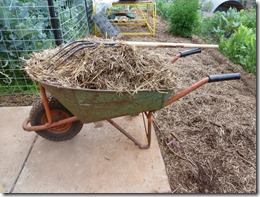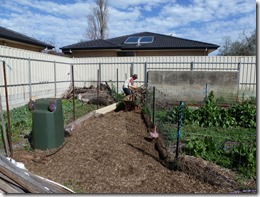At the end of winter, below-average rainfall and unseasonably hot weather have combined to push the panic-button on capturing the last rainfall events in the soil before the eight months of dry weather are upon us. The main rainwater tanks are full, so now I need to lock down twice that volume of water in the ‘big brown tank’ that is the garden itself; this is done by mulching the surface under a thick layer of friable straw.
So all the fun of planting out Spring seeds and seedlings goes on hold, and the winter stores of barley straw – laid down in autumn on the paths and since worked over thoroughly by the chickens and watered by winter rainfall – is moved into the orchard under the burgeoning green of the table grapes, peaches and raspberries. Other beds will be mulched in similar fashion over the coming weeks.
Simply covering the soil in this way is worth the original cost of the straw three times over; mulch reduces the water bill and adds to the nutritional stores of carbon in our soils.
Somewhere in the next decade, I’ll get out of the work force and will be looking to these same soils to feed both cook and gardener for a further twenty years. Such wonderfully warm and rich organic soils can’t be trucked in;  they need to be created in-situ over the span of at least a decade.
they need to be created in-situ over the span of at least a decade.
Mulch has additional benefits. It encourages earth worms to work up to the moist cool surface of the soil just below the mulch, and to mix this organic matter deeper down. The wormholes left behind (called ‘macropores’) allow the soil to breathe and roots to find their way deeper down, giving our fruit and vegetable crops added resilience when the hot weather comes.



0 comments:
Post a Comment